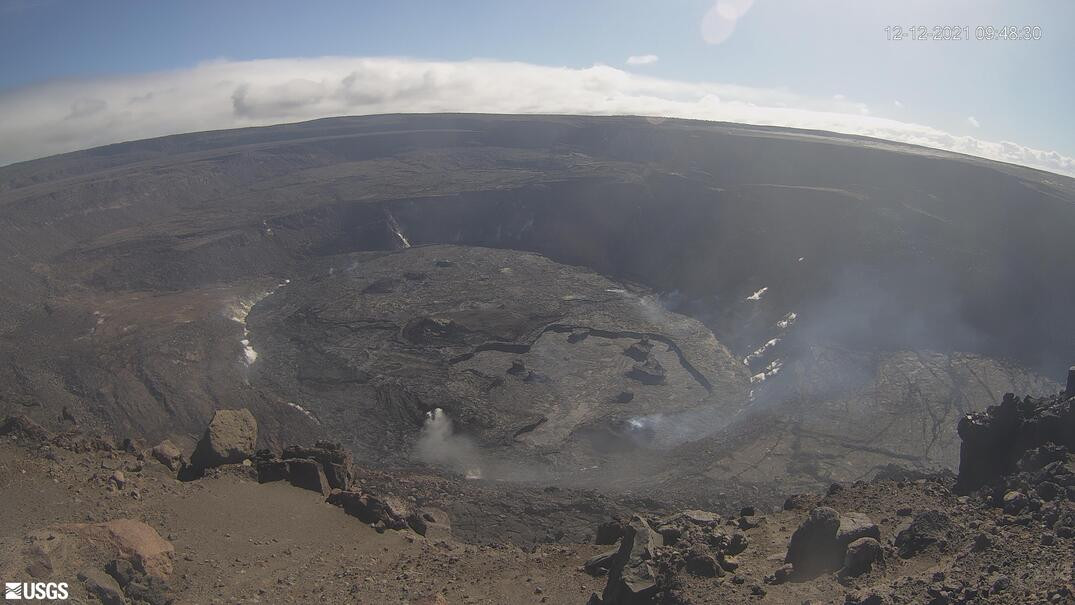(BIVN) – The eruption at Kīlauea is showing reduced activity over the past day, scientists say, as lava remains confined to the summit area within Hawaiʻi Volcanoes National Park.
The USGS Hawaiian Volcano Observatory reported on Sunday that the eruption at Halema‘uma‘u crater continues “with reduced vigor”. Deflationary tilt began Saturday evening around 9 p.m. and continues this morning, scientists added.
Aside from the decrease in activity, the latest update is similar to other recent USGS reports. From the HVO:
Activity Summary: Kīlauea volcano is erupting from a single vent in the western wall of Halemaʻumaʻu crater. The lava lake remains active in the western portion of the crater, with reduced activity over the past day. All recent lava activity remains confined within Halemaʻumaʻu crater in Hawai‘i Volcanoes National Park.
Summit Observations: The eruption of lava continues from the western vent in Halema‘uma‘u crater, with reduced vigor over the past day. Deflationary tilt began yesterday evening around 9 p.m. and continues this morning. Earthquake activity remains below background. The most recent measurement of sulfur dioxide (SO2) emission rate on December 9, 2021, was approximately 3500 tonnes per day.
Halemaʻumaʻu Lava Lake Observations: Lava continues to erupt from a single vent in the western wall of Halemaʻumaʻu crater, supplying lava into the lava lake that is contained within the western portion of the crater. Lake activity has decreased significantly over the past day, associated with deflationary tilt and reduced seismic tremor, similar to the events preceding the brief pause last week. Spattering continues within a small lava pond at the vent, and sporadic ooze-outs of lava are present along the solidified lake margins. The lake has seen a total increase of about 65 meters (213 ft) since lava emerged on September 29. The total erupted volume since the beginning of the eruption was estimated to be about 30 million cubic meters (7.8 billion gallons) on November 16.
East Rift Zone Observations: No unusual activity has been noted in the Kīlauea East Rift Zone. Low rates of ground deformation and seismicity continue along the rift zones. SO2 and hydrogen sulfide (H2S) emissions from Puʻuʻōʻō were below instrumental detection levels when last measured on January 7, 2021.
Hazard Analysis: This new eruption at Kīlauea’s summit is occurring within a closed area of Hawai’i Volcanoes National Park. Therefore, high levels of volcanic gas are the primary hazard of concern, as this hazard can have far-reaching effects down-wind. Large amounts of volcanic gas—primarily water vapor (H2O), carbon dioxide (CO2), and sulfur dioxide (SO2)—are continuously released during eruptions of Kīlauea Volcano. As SO2 is released from the summit, it reacts in the atmosphere to create the visible haze known as vog (volcanic smog) that has been observed downwind of Kīlauea. Vog creates the potential for airborne health hazards to residents and visitors, damages agricultural crops and other plants, and affects livestock. For more information on gas hazards at the summit of Kīlauea, please see (this website). Vog information can be found at vog.ivhhn.org.
Additional hazards include Pele’s hair and other lightweight volcanic glass fragments from the lava fountains that will fall downwind of the fissure vents and dust the ground within a few hundred meters (yards) of the vent (s). Strong winds may waft lighter particles to greater distances. Residents should minimize exposure to these volcanic particles, which can cause skin and eye irritation.
Other significant hazards also remain around Kīlauea caldera from Halemaʻumaʻu crater wall instability, ground cracking, and rockfalls that can be enhanced by earthquakes within the area closed to the public. This underscores the extremely hazardous nature of Kīlauea caldera rim surrounding Halemaʻumaʻu crater, an area that has been closed to the public since early 2008.


by Big Island Video News11:12 am
on at
STORY SUMMARY
HAWAIʻI VOLCANOES NATIONAL PARK - Scientists say deflationary tilt began Saturday evening around 9 p.m. and continues Sunday morning.